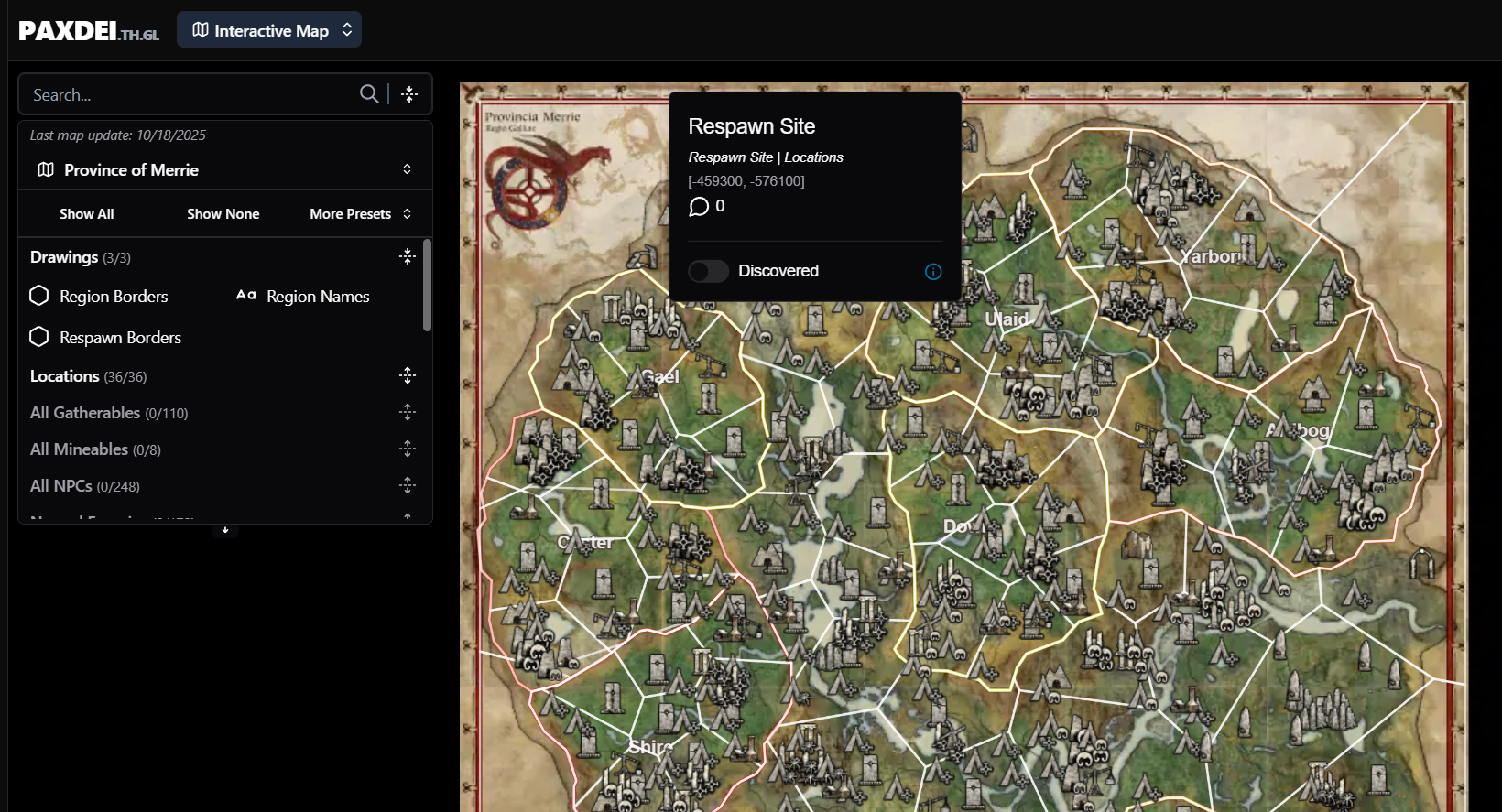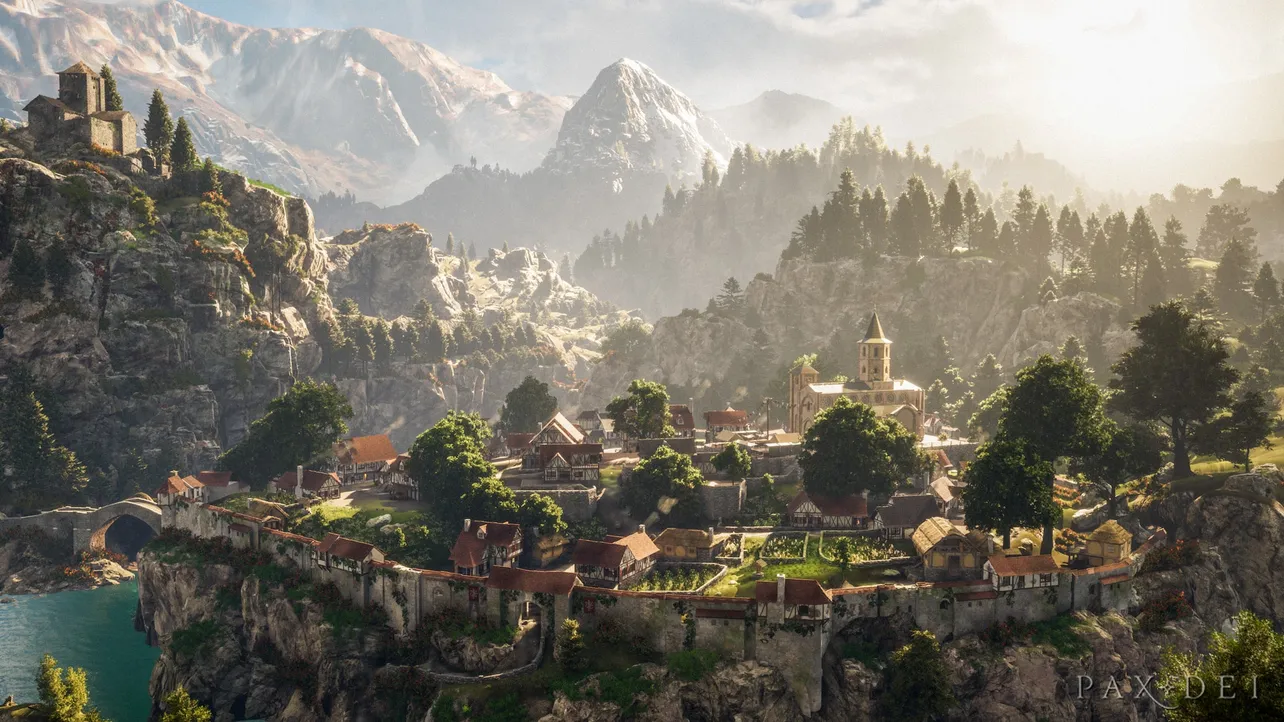Pax Dei doesn’t ship with a detailed in‑game world map, and resources are intentionally unevenly distributed across biomes and valleys. Community web maps fill that gap with searchable layers for plants, minerals, NPCs, and sites. The result: faster routes to what you need, less backtracking, and better planning for clan projects. The studio’s world FAQ confirms there’s no detailed in‑game map and outlines how resources respawn and where they tend to appear.
Read Pax Dei’s world FAQ once; it sets expectations for regions, provinces, and resource behavior.
Interactive map options (web)
Two web maps stand out for coverage and useful layers. One focuses on granular gathering filters and crafting categories; the other emphasizes world markers and territory context.
| Map (web) | Coverage | Resource layers and filters | POI markers / highlights | Status |
|---|---|---|---|---|
| The Hidden Gaming Lair interactive map | Merrie, Kerys, Inis Gallia, Lyonesse, Ancien |
Drawings: Region Borders, Region Names, Respawn Borders Locations: 36/36 All Gatherables: 0/110 All Mineables: 0/8 All NPCs: 0/248, Named Enemies: 0/178 Craft toggles: Alchemy (0/29), Armorsmithing (0/22), Baking (0/9), Blacksmithing (0/10), Carpentry (0/19), Charcuterie (0/11), Consumables (0/31), Cooking (0/24), Fletching (0/4), Jewelry Making (0/4), Leatherworking (0/26), Tailoring (0/26), Weaponsmithing (0/16), Winemaking and Brewing (0/5), Others (0/87) Featured finds: Edible Plants, Mushrooms, Plants, Cooking Ingredients, Textile Materials, Grains |
Layered toggles and presets; quick “Show All/Show None” controls | Last map update: 10/18/2025 |
| Pax Dei Universe interactive map | Ancien, Lyonesse, Merrie, Kerys, Inis Gallia | Resources, markers, points of interest, territories | Markers include: cave, empire (small/large), empire dungeon, gateway (open/closed), holy site, mini‑camp, quarry (small/large), respawn site, ringfort (small/large), site, stone circle, windmill | Regions and markers listed; zoom tiles available |

Use filters to find materials fast
The granular toggle system is the quickest path to a clean route. Start broad, then narrow:
- Enable Region Borders and Region Names to situate yourself, then add Respawn Borders if you’re planning repeat runs.
- Turn on All Gatherables to surface everything you can pick up; then deselect categories you don’t need so only target nodes remain.
- Switch on All Mineables when you’re chasing ore or stone. Keep NPCs and Named Enemies off until you specifically need them to reduce map noise.
- For crafting runs, toggle by discipline (e.g., Tailoring or Alchemy) to reveal only relevant inputs.
Tip: “Show All / Show None” is useful for quickly clearing clutter between tasks. Rebuild your view per route rather than scrolling a single busy layer set.
Regions, provinces, and home valleys (context)
The world is divided into large regions, then provinces, with key “heartland” provinces that contain multiple home valleys where players claim land and build. Current community maps focus on a slice of Gallia, reflecting the areas most players interact with day to day. That structure matters for gathering: valleys and biomes influence what grows or spawns nearby, and resource placement skews by geology rather than being evenly spread.
What the markers mean
Beyond raw materials, site markers help plan safer or more efficient routes:
- Quarries and quarry_small: stone‑focused sites that can anchor a mining loop.
- Ringfort variants and empire sites: combat‑leaning zones for specific drops and challenges.
- Gateways (open/closed) and respawn sites: useful for navigation and recovery points when stringing together long runs.
- Caves, holy sites, stone circles, windmills, and mini‑camps: landmarks that double as route memory aids and waypoints.
If you’re planning a mixed loop, place resource clusters between predictable landmarks—windmill to quarry to ringfort, for example—so you can adapt on the fly without losing the path.
Overlays and desktop apps
A desktop overlay app for Pax Dei maps was pulled for terms‑of‑service reasons and is no longer functional. Use the web maps instead; the approved website remains live.
Respawns, claimed land, and why routes shift
Resources generally respawn, but different rules apply on claimed land, and distribution is asymmetric. Expect routes to evolve as player settlements expand and as you move between biomes. The practical approach is to save a few loop variants per province and flip filters on your map to match the goal—bulk textiles one day, charcuterie or alchemy inputs the next.
Pick a province, switch on borders and a single material category, and trace a simple loop that passes at least one landmark. Keep your map layers lean, and refresh your saved presets when new updates roll in. The less time you spend hunting for nodes, the more time you’ll have to build, trade, and fight.

